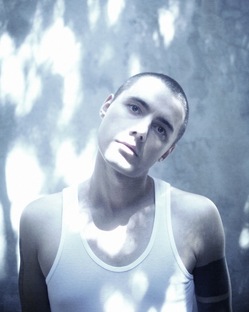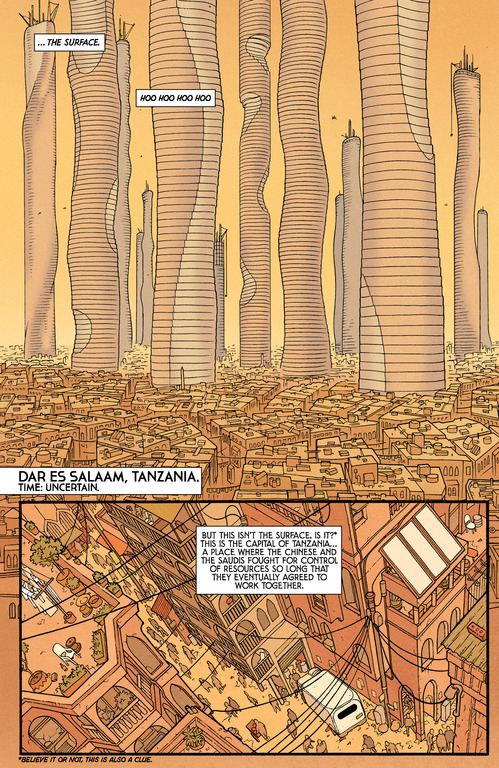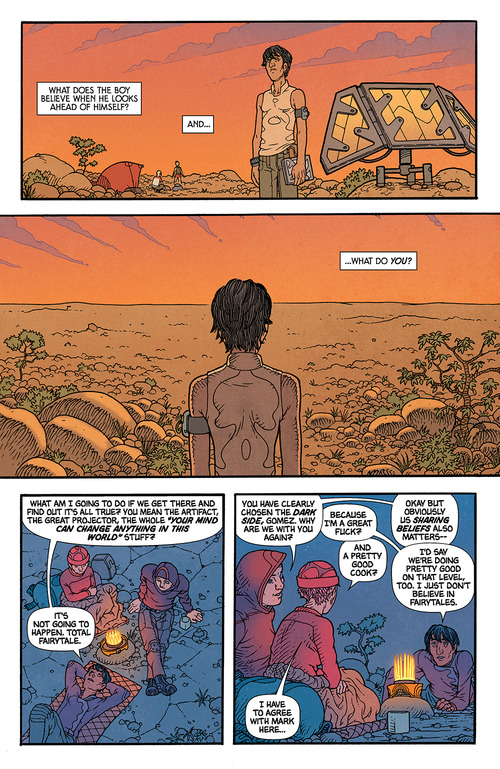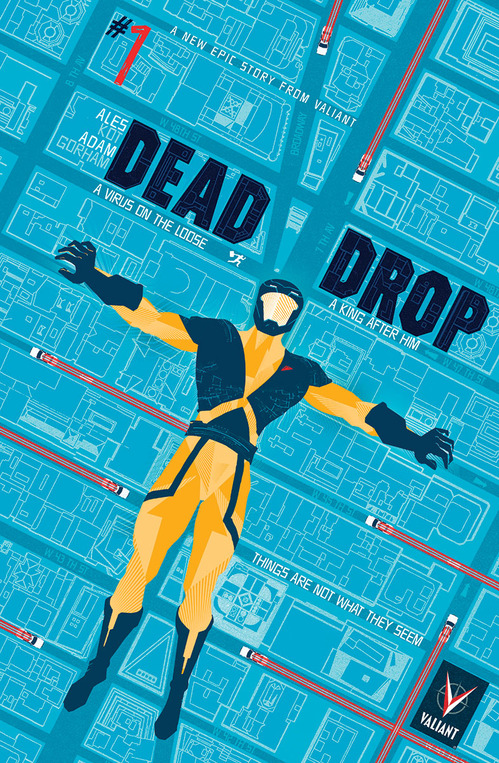When reading Ales Kot’s work, it can be helpful to take note of just when the postmodern writer begins to strip your expectations away and expand your mind. His ongoing series Zero begins as a near-future story of espionage and slowly turns into a meditation on identity and memory, even as it maintains the weird technology and nail-biting action that are hallmarks of the genre. His new book, The Surface, takes several of those ideas and pushes them even further: there are sinister corporations and strange technological advances, but the narrative also includes a self-questioning component through captions and dialogue that tug at the reader’s assumptions.
Paste emailed with Kot about both books, as well as his recently announced Dead Drop miniseries for Valiant Entertainment. The resulting conversation spans a host of topics, from creator-owned comics to the nature of storytelling itself. Kot is one of the few writers who can cite experimental writer and theorist Kathy Acker and M.O.D.O.K. in the same interview and make it seem entirely of a piece. That blend of theoretical headiness and pulp excitement also exemplifies the sheer innovation found throughout Kot’s work.
Portrait Photo by Clayton Cubitt
![]()
Paste: Where did the initial idea for The Surface come from?
Ales Kot: My overwhelming need to be loved and appreciated. Back in 2009 or so I crafted a story that would be relatively simple, carry a charge and be visually extravagant. Throughout the years the project morphed as I morphed—it’s sometimes impossible to write a story well if it originally came a long time ago and you’re trying to keep it as it was, especially if you’re committed to self-evolution. And since I am exactly that, I watched The Surface morph with me, which nicely connects with the premise of the entire story, which is three young hackers in love (yes, they are poly) go off the back roads of Tanzania to discover a place called the Surface which, yes, does indeed morph according to what’s inside its visitors.
I can trace the influences back to Moebius, Frank Miller’s and Lynn Varley’s Ronin, Kubrick’s 2001: A Space Odyssey, Alex Garland’s The Beach, Andrei Tarkovsky’s Stalker. Milligan’s and Fegredo’s Enigma, too, in one particular aspect. But the true way to answer why I found The Surface is that I wanted to make a comic that would be published, loved and truthfully reflective of what’s inside me.
Paste: From the first page of the first issue, you have the captions commenting on the story—I’m thinking of the “Believe it or not, this is also a clue” footnote.
Kot: Yes. It might all get a little bit meta.
Paste: Do you have a sense of how long The Surface will run?
Kot: Either four issues, ten years or anything in between. Which means: not really. I suspect it will be four issues, but it could easily be much longer. The story will tell us as we go on, and there certainly is enough of a universe, a world and characters to explore.
Paste: What appealed to you about using Tanzania as a setting for the first issue?
Kot: I genuinely don’t remember where that originally came from, but I know what my perception of it is now: Tanzania is a unique crossroad, and so are certain other African states, in that the Saudis, the Chinese and to a much lesser extent Americans, Russians and others are currently working to essentially own it. Tanzania is therefore a perfect place to explore semiocapitalism and accellerationism. And from there—its roots, its history, its people. What will be especially interesting is seeing where the merging happens and how the cohabitation, parasitism and resistance evolve. Using SF enables me to heighten what is happening now, because when SF speaks of the future it usually does speak about present human condition.
Paste: Does the first issue introduce the reader to all of the primary characters, or will more show up in the future?
Kot: The thing is, I rarely think of people or any beings as characters. I find that perceiving them as characters instead of as beings tends to simplify and flatten them, and what I want to achieve with my writing and co-creating is depth. Every being in a story (which is really a cosmos in its own right) matters.
This leads to me not necessarily knowing how to answer your question in a straightforward manner. Part of the why is also that I don’t obsessively outline every project from the beginning to the end. In some cases I do, but then I take some leaps and the project evolves, becomes new, unpredictable. William Gibson starts without an outline and with the first sentence. James Ellroy outlines are sometimes longer than the books. And what would Kathy Acker do? I don’t know. I know that my process is legitimate and it takes many shapes, and in case of The Surface the shape is that of a project that evolved too many times for me to say anything but more beings will show in the future, and the ones who have the most “screen time” in the first issue are mostly the ones who will be mainly around in the first four. But there’s certainly room for surprises.
Paste: The third collection of Zero is due out soon. How does that fit into the overall shape of the series?
Kot: Imagine you have spent most of your life oblivious to a black thing in your chest and stomach that is slowly consuming you. Then you discover it’s there and struggle against it. There is a fear in the struggle as you see your body collapse and scar. Then you make steps that lead you to take bits of it away, change bits of it. You see change is possible but the black thing is still there and its consequences find you again no matter how far you go. So what do you do next? You go face the consequences.
Paste: What is your process for seeking out the artist teams for a particular story? Has there ever been a conflict, where a particular issue needed to be re-envisioned to fit a particular artist’s style?
Kot: The process is whatever it has to be—which really fits my process overall. I’m learning things but the main thing to learn is that there are always things to learn, so staying fluid helps with that. The fluidity is what helps Zero morph. There were outlines but at the end of the day what’s the best story to tell with this particular artist and what’s the best story to tell? The key is not making a compromise but finding the space where both of these questions find the right answer together. “The best” being a shorthand for “true.” I always wanted to be a poet.
Paste: Zero’s captions often reference particular years. When a similar panel appears in The Surface, it reads “Time: Uncertain.” Do you see these two works in dialogue in other ways as well?
Kot: Yes. Everything I do is in dialogue with all the other works. Communication, like water, is a constant of life, a flow of information that cannot be stopped. For example, the earlier-mentioned overwhelming need to be loved and appreciated is something that at first seemed to come from me being bullied as a kid, but as I dug deeper through creating art, sessions with my psychologist and general introspection, I realized that it came from having some deep-seated traumas within my family—at least about seventy years back. So processing the anxiety wrapped around loss, around not being loved enough, around not being seen clearly enough, became paramount, and it popped up in the stories me and my collaborators have told, well enough that I started taking those threads and following them. So much of Zero is about loss, and The Surface certainly plays with that same anxiety in a different but similar way. M.O.D.O.K. in my Secret Avengers run is exactly that—a traumatized kid inside a big brain terrorist on mechanical legs. Who says comics can’t change the world? They sure are changing me.
And—there’s other ways. I won’t uncover the specific link, but The Surface also connects to Change, and in other ways even to Wild Children.
Then there’s opposites, like the captions that reference years in Zero and define time as uncertain in The Surface, or the overall style of the third collection of Zero, which is extremely sparse on words, and therefore strongly contrasts with the word collage of The Surface. Yes, the comics are certainly in dialogue, and not just these two, but all of them.
Paste: I saw the announcement last week about Dead Drop—how did that come about?
Kot: People at Valiant Entertainment love me and wanted to do something with me. I had a little room in my schedule and I thought, this could be interesting, I like them, we vibe on what I’d like to do, and I need to pay my taxes soon — let’s do it. So I came up with a story that takes certain characters from their universe and explores their chase for a virus stolen by this young anarchist parkour runner girl. Subtext being semio-and-other-capitalism, lies and women getting things done, which is sort of an updated title of sex, lies and videotape, I guess.
Paste: Do you have different goals in mind for your creator-owned work and the work that you do in shared universes?
Kot: Do you mean do I have different goals between working for myself or working for corporations? No. The goal is always to truthfully express the story, and in order for the story to be true, it has to come from feeling. This feeling can arise from a collaborative environment between the publisher, editors and the creators, or from a collaborative environment between the collaborators only.
Now when writing and collaborating on comics published by corporations which own what we co-create I remember this: I do not have complete control over what goes on the page. Therefore I am not creating in a creatively safe environment, but in an environment that can be polluted by ideas other than what the story is, like greed or anxiety or shame. This is not a diss in regards to the publishers I worked or work with other than Image, where I have 100% creative control: with vast majority of the people at all publishers I worked with I sense a commendable commitment to creating a safe space for the creators to play as long as it is within the rules set by the company.
And therein lies the problem. In a certain sense, most of human civilization is currently stuck on Nostromo. A corporate ship that, at the end of the day, does not care about the survival of its crew as much as it cares about pure profit. The layoffs don’t hurt as much until it’s your head on the chopping block. What I am interested in is evolution, which means I need to purposefully find ways to express myself without paying attention to corporate guidelines. This means I am engaged in a continuous process of leaping into the darkness, which is what Ripley does at the end of Alien as well. Spoilers.
The question I ask myself nearly every day is this: how do I conduct my actions in a way that is truthful and conducive to creating a world without corporate warfare waged against the majority? The 99% versus the 1% question is catchy, but not precise. It’s more like 70-100 people owning most of the planet and steadily increasing their financial hold through strategically planned buyouts, layoffs and marriages while the rest of us is getting drained and discarded. Current corporate structures are created to serve the vampire minority.
I am not advocating for war against them. I am advocating for creating and participating in structures that render their warfare capability obsolete and tell them it’s time to evolve and contribute to creating an improved ecosystem where no-one has to be exploited in order for us all to benefit.
So what I’m doing is a careful combination of push and pull, engage and disengage. I love working with Image Comics because it posits a new, better, cleaner way of creating art and engaging in economy. I own what I make, my co-creators co-own, we all benefit, we all make our contracts together. The company is not greedy and only takes what it needs to keep its growth going, letting us benefit significantly in ways most corporations do not. The way Image Comics does it is the new standard.




